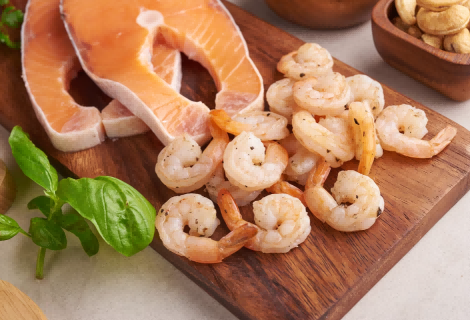 Import News
Import News
 28-08-2023
28-08-2023
Crustaceans
A deeper look at China's imported species makes it clear how important crustaceans are to Chinese seafood consumers.
In 2022, China imported $9.8 billion worth of crustaceans (categorized by HS codes 0306 and 1605), a 37% increase from 2021. In volume terms, crustacean imports increased by 34% to 1.126 million tons.
Even though China's seafood imports are increasing, the most important category is crustaceans, such as warm-water shrimp, cold-water shrimp, lobsters, snow crabs, king crabs, and a variety of different types of crabs, whose imports are growing much faster.
In 2021, China imported $5.65 billion worth of warm-water shrimp, primarily farmed, which is China's largest seafood import byproduct. This value increased by 53 percent compared to 2021.
The volume of imports increased by 43 percent to 874,000 tons, the highest direct import volume recorded to date.
There are many reasons why shrimp is so popular in China. China's declining domestic shrimp production is also a gift to importers. People are becoming more and more dependent on imported shrimp.
Another notable shrimp import is cold water shrimp (HS code 030616). Despite rising market prices, the value of crustacean imports increased by 108 percent to $542.6 million and the volume of imports increased by 69 percent to 72,000 tons.
In fact, cold-water shrimp grow even better than warm-water shrimp. People prefer wild-caught; they believe wild shrimp is safer, more nutritious and tastier.
Crabs, lobsters
China also imports large quantities of crabs and lobsters. in 2022, the country imported $1.3 billion worth of live, fresh, or frozen crabs (traded under HS code 030633), an increase of 6 percent from 2021. Volume increased by 7 percent to 74,597 tons.
The majority of China's crab imports come from Russia, with supplies amounting to $710 million, up 10 percent. in June 2021, the U.S. and Europe banned or restricted imports of Russian king crab. Since then, more live king crab has been exported to China and South Korea than frozen king crab to the United States and Europe.
However, a significant increase in Russian supply has depressed prices. prices for Russian king crab, snow crab, and Russian cold-water shrimp all declined in 2021. However, lower prices mean more value for Chinese, Japanese, and Korean consumers, spurring imports.
China imported fewer U.S. lobsters (also known as Boston lobsters), a rare example of a decline in crustacean imports.In 2022, China imported $614.4 million worth of live, fresh, or cold U.S. lobsters, a decline of 10%, and the volume of imports fell 9% to 23.431 tons.
2021 was a very good year (for lobster imports) - the most important market, Shanghai, was blocked for two months. lobster imports resumed in the second half of 2022. If you look at the first two months of 2023, lobster imports recovered further.
On the other hand, imports of another type of lobster - live, fresh or chilled (HS code 030631) - increased significantly.In 2022, China imported $892.3 million worth of rock lobsters, up 43 percent, with imports increased 57 percent to 16,932 tons.
China's finfish imports
China also imported $5.1 billion worth of whole fish, equivalent to 2.06 million tons. This represents a 45 percent increase in value and a 28 percent increase in volume compared to 2021.
Whether China's imports of cod and hake increase or decrease, cod and hake are not really for domestic consumption; 80 percent or 90 percent of these fish are imported, processed, and re-exported.
In 2021, China's largest supplier of frozen whole fish was Russia, with exports valued at $1.78 billion, up 71 percent, while Russian exports reached 886,000 tons, up 54 percent. This follows a recovery in 2021 after a sharp decline in imports due to the strict Chinese COVID-19 customs agreement.
In contrast to other whitefish species such as balsa, neither pollock nor cod have made a big push into the Chinese market. This is because pollock and cod are not marketed very well, whereas balsa is marketed very well in China.
If you look at the sweet and sour dishes and grilled fish at the most popular fish restaurants in China, you will find balsa fish everywhere. Basa fish is loved by many Chinese restaurants because of its cheap, non-spiny nature.
But where can you find expensive cod and mackerel? You can only find them in first-tier cities, and the consumer base is small.
Salmon market flat
China's salmon import growth was also lower than expected. in 2021, China imported $736.7 million worth of whole fresh Atlantic salmon, a 26% increase. However, imports fell 8% to 49,018 tons.
Salmon is "very expensive" in China, he said, coupled with record airfreight prices and dietary choices that are more limited than shrimp. If land-based farmed salmon production only accounted for 5% or 10% of the total Chinese market, it would not change the overall price structure in China, even at lower prices.
Category
Leave Message for Demo Request or Questions


 T-info
T-info T-discovery
T-discovery

 My
Tendata
My
Tendata Market Analysis
Market Analysis Customer
Development
Customer
Development Competitor
Monitoring
Competitor
Monitoring Customer Relationship
Customer Relationship






































































































































